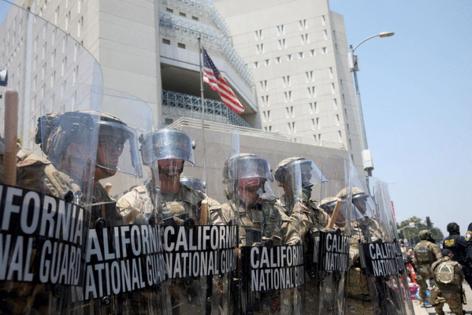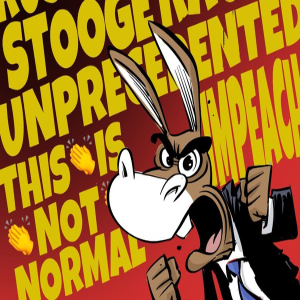Analysis: Was it legal for Trump to send the National Guard to LA during protests?
Published in News & Features
President Donald Trump’s decision to overrule California’s governor and send National Guard troops and now active-duty Marines to Los Angeles amid protests over immigration sweeps is a ‘highly unusual’ move that could be considered legal under some readings of the law and questioned under others, experts said Monday.
The deployment could also lead to unintended consequences, including the possibility of additional violence between guard members and the public, experts said.
“It is unclear that the president has the authority to nationalize the California National Guard in these circumstances,” said Erwin Chemerinsky, a constitutional scholar and dean of the law school at UC Berkeley.
Such a move could violate the 10th Amendment of the U.S. Constitution, which limits federal power over the states, he said, as well as federal law that requires a bona fide rebellion or other limited circumstances before such troops can be used domestically.
“It’s highly unusual for the president to nationalize the National Guard,” said Leslie Gielow Jacobs, a professor of constitutional law at the University of the Pacific’s McGeorge School of Law in Sacramento.
The laws governing such deployments are open to interpretation, Jacobs said, and courts may be reluctant to step in to undo the president’s actions, Jacobs said.
Trump administration officials ordered up to 2,000 National Guard members to deploy to the nation’s second-largest city over the weekend, as protests grew over unannounced raids by U.S. Immigration and Customs Enforcement officers targeting day laborers at a Home Depot and workers in the city’s garment district, among others.
Both moves came over the objections of California officials led by Gov. Gavin Newsom. On Monday, Attorney General Rob Bonta announced the state would file suit, asking a judge to block Trump’s order for up to 60 days. On Monday, Defense Department officials said an additional 700 Marines stationed at Twentynine Palms would also be deployed. Activated under a different set of laws, the active duty personnel would be used to protect federal buildings as well.
The first group of 300 troops arrived on Sunday from San Diego, engaging in roles involving the protection of federal property and personnel, the military’s U.S. Northern Command said.
In activating the Guard, Trump pointed to a provision of the law governing the use of the military, Title 10, that authorizes him to do so under certain circumstances, when there is an invasion, a rebellion, or the president is unable to enforce the laws of the United States.
The same law, however, says such orders “shall be issued through the governors of the states.” But far from ordering such a deployment, California Gov. Gavin Newsom actively opposed it, and on Monday said he would file a lawsuit against the president’s action.
“Donald Trump is creating fear and terror by failing to adhere to the U.S. Constitution and overstepping his authority. This is a manufactured crisis to allow him to take over a state militia, damaging the very foundation of our republic,” Newsom said in a press release.
The order, he said, violates the 10th Amendment, which defines the separation of powers between the states and the federal government.
Jacobs said that cogent legal arguments could be made on both sides of the question of the president’s power in this situation, and that ultimately judges would have to weigh federal laws that do allow the president to mobilize the National Guard against other provisions in the law that limit what troops can do and imply involvement in most cases from the state’s governor.
The Posse Comitatus Act of 1878, signed by President Rutherford B. Hayes, limits the role that federal troops can play when deployed domestically, Jacobs said, which is why the troops are performing support roles, protecting federal property and personnel, she said.
“The president can say ‘I need to nationalize the National Guard,’ but the National Guard is limited to doing protection activities to the other law enforcement actors,” she said. “They can’t arrest people.”
But if Trump were to invoke a different law, the Insurrection Act, he would be able to deploy militia troops to enforce laws on American soil, she said. Thus far, the president has not done so.
Whether or not the deployment is found legal by the courts, sending National Guard troops to a domestic situation can have unintended — and sometimes lethal — consequences, said William Deverell, a historian at USC.
Among the most dramatic examples is the killing of four college students who were protesting the Vietnam War at Kent State University in Ohio in 1970, Deverell said.
“Things went horribly and tragically awry when those guardsmen turned and fired with live ammunition,” Deverell said. “They were on the move away from the protesters and then turned and fired on them.”
In another case, the National Guard was activated by California’s then-Gov. Henry Markham during the 1894 Southern Pacific Railway strike in Sacramento, Deverell said.
But the guardsmen, who all came from the Sacramento area, ended up siding with the strikers, Deverell said, some even leaving their posts to drink lemonade with them.
Angelenos welcomed guard troops when they helped protect people and property during the recent fires that destroyed the communities of Altadena and Pacific Palisades, he said. But they are less likely to respond positively to troops sent without the governor’s approval to police their streets during protests.
“If you put the guard into this kind of turmoil and chaos do you stretch the allegiance of the public and their good faith in this regard? I bet you do,” he said.
_____
©2025 The Sacramento Bee. Visit sacbee.com. Distributed by Tribune Content Agency, LLC.







Comments